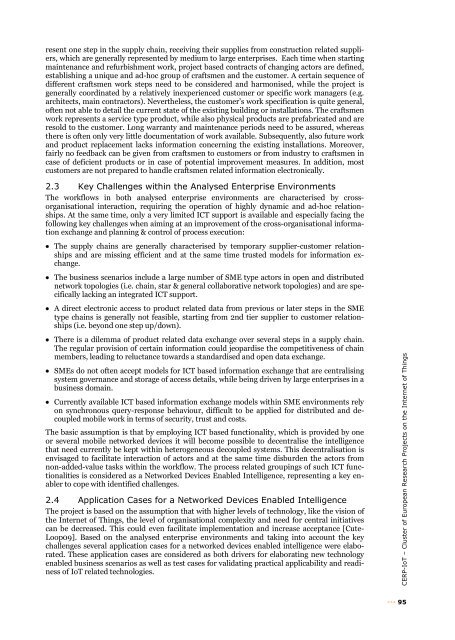Vision and Challenges for Realising the Internet of Things
Vision and Challenges for Realising the Internet of Things
Vision and Challenges for Realising the Internet of Things
You also want an ePaper? Increase the reach of your titles
YUMPU automatically turns print PDFs into web optimized ePapers that Google loves.
esent one step in <strong>the</strong> supply chain, receiving <strong>the</strong>ir supplies from construction related suppliers,<br />
which are generally represented by medium to large enterprises. Each time when starting<br />
maintenance <strong>and</strong> refurbishment work, project based contracts <strong>of</strong> changing actors are defined,<br />
establishing a unique <strong>and</strong> ad-hoc group <strong>of</strong> craftsmen <strong>and</strong> <strong>the</strong> customer. A certain sequence <strong>of</strong><br />
different craftsmen work steps need to be considered <strong>and</strong> harmonised, while <strong>the</strong> project is<br />
generally coordinated by a relatively inexperienced customer or specific work managers (e.g.<br />
architects, main contractors). Never<strong>the</strong>less, <strong>the</strong> customer’s work specification is quite general,<br />
<strong>of</strong>ten not able to detail <strong>the</strong> current state <strong>of</strong> <strong>the</strong> existing building or installations. The craftsmen<br />
work represents a service type product, while also physical products are prefabricated <strong>and</strong> are<br />
resold to <strong>the</strong> customer. Long warranty <strong>and</strong> maintenance periods need to be assured, whereas<br />
<strong>the</strong>re is <strong>of</strong>ten only very little documentation <strong>of</strong> work available. Subsequently, also future work<br />
<strong>and</strong> product replacement lacks in<strong>for</strong>mation concerning <strong>the</strong> existing installations. Moreover,<br />
fairly no feedback can be given from craftsmen to customers or from industry to craftsmen in<br />
case <strong>of</strong> deficient products or in case <strong>of</strong> potential improvement measures. In addition, most<br />
customers are not prepared to h<strong>and</strong>le craftsmen related in<strong>for</strong>mation electronically.<br />
2.3 Key <strong>Challenges</strong> within <strong>the</strong> Analysed Enterprise Environments<br />
The workflows in both analysed enterprise environments are characterised by crossorganisational<br />
interaction, requiring <strong>the</strong> operation <strong>of</strong> highly dynamic <strong>and</strong> ad-hoc relationships.<br />
At <strong>the</strong> same time, only a very limited ICT support is available <strong>and</strong> especially facing <strong>the</strong><br />
following key challenges when aiming at an improvement <strong>of</strong> <strong>the</strong> cross-organisational in<strong>for</strong>mation<br />
exchange <strong>and</strong> planning & control <strong>of</strong> process execution:<br />
The supply chains are generally characterised by temporary supplier-customer relationships<br />
<strong>and</strong> are missing efficient <strong>and</strong> at <strong>the</strong> same time trusted models <strong>for</strong> in<strong>for</strong>mation exchange.<br />
The business scenarios include a large number <strong>of</strong> SME type actors in open <strong>and</strong> distributed<br />
network topologies (i.e. chain, star & general collaborative network topologies) <strong>and</strong> are specifically<br />
lacking an integrated ICT support.<br />
A direct electronic access to product related data from previous or later steps in <strong>the</strong> SME<br />
type chains is generally not feasible, starting from 2nd tier supplier to customer relationships<br />
(i.e. beyond one step up/down).<br />
There is a dilemma <strong>of</strong> product related data exchange over several steps in a supply chain.<br />
The regular provision <strong>of</strong> certain in<strong>for</strong>mation could jeopardise <strong>the</strong> competitiveness <strong>of</strong> chain<br />
members, leading to reluctance towards a st<strong>and</strong>ardised <strong>and</strong> open data exchange.<br />
SMEs do not <strong>of</strong>ten accept models <strong>for</strong> ICT based in<strong>for</strong>mation exchange that are centralising<br />
system governance <strong>and</strong> storage <strong>of</strong> access details, while being driven by large enterprises in a<br />
business domain.<br />
Currently available ICT based in<strong>for</strong>mation exchange models within SME environments rely<br />
on synchronous query-response behaviour, difficult to be applied <strong>for</strong> distributed <strong>and</strong> decoupled<br />
mobile work in terms <strong>of</strong> security, trust <strong>and</strong> costs.<br />
The basic assumption is that by employing ICT based functionality, which is provided by one<br />
or several mobile networked devices it will become possible to decentralise <strong>the</strong> intelligence<br />
that need currently be kept within heterogeneous decoupled systems. This decentralisation is<br />
envisaged to facilitate interaction <strong>of</strong> actors <strong>and</strong> at <strong>the</strong> same time disburden <strong>the</strong> actors from<br />
non-added-value tasks within <strong>the</strong> workflow. The process related groupings <strong>of</strong> such ICT functionalities<br />
is considered as a Networked Devices Enabled Intelligence, representing a key enabler<br />
to cope with identified challenges.<br />
2.4 Application Cases <strong>for</strong> a Networked Devices Enabled Intelligence<br />
The project is based on <strong>the</strong> assumption that with higher levels <strong>of</strong> technology, like <strong>the</strong> vision <strong>of</strong><br />
<strong>the</strong> <strong>Internet</strong> <strong>of</strong> <strong>Things</strong>, <strong>the</strong> level <strong>of</strong> organisational complexity <strong>and</strong> need <strong>for</strong> central initiatives<br />
can be decreased. This could even facilitate implementation <strong>and</strong> increase acceptance [Cute-<br />
Loop09]. Based on <strong>the</strong> analysed enterprise environments <strong>and</strong> taking into account <strong>the</strong> key<br />
challenges several application cases <strong>for</strong> a networked devices enabled intelligence were elaborated.<br />
These application cases are considered as both drivers <strong>for</strong> elaborating new technology<br />
enabled business scenarios as well as test cases <strong>for</strong> validating practical applicability <strong>and</strong> readiness<br />
<strong>of</strong> IoT related technologies.<br />
CERP-IoT – Cluster <strong>of</strong> European Research Projects on <strong>the</strong> <strong>Internet</strong> <strong>of</strong> <strong>Things</strong><br />
95
















